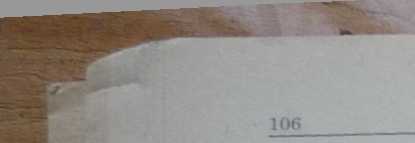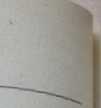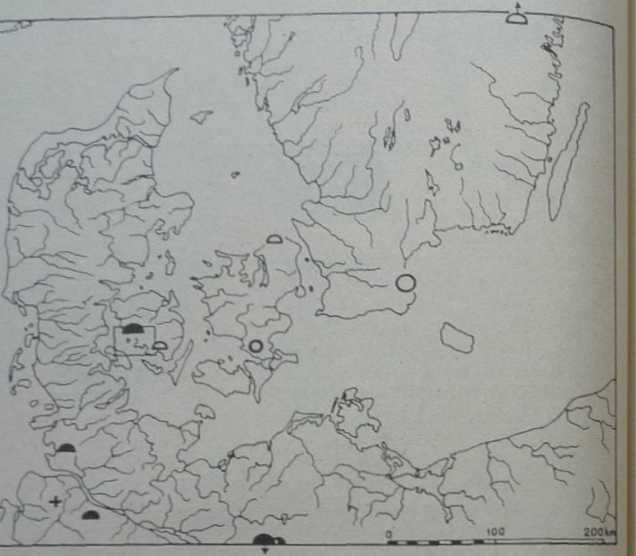P1170416 (2)



Henrik Thrane

Fig. 5. Map of exiraordxnarily rich graves in <he Bronze Age Prunkgraber. Circles: Early Bronze Age (Kivik and Skallerup); half circles: La te Bronze Age (open per. IV: HAga. Lydshej. V. Skjermge; filled per. V: Lusehąj, Kaisersberge, Osterberg. Seddin. Kemnitz). cross: flat grave from Alfstedt. After H. Thrane 1984a
display exemplified in the great barrows have something to do with exchange as suggested long ago (E. Sprockhoff 1957), then we should expect another such centre of wealth in Pomerania (fig. 5)!
There are other lines of communication from the Elbę region northwards and it would be nice to know morę about them, how they fiinctioned and what part they played in the exchange of ideas of the most varied kind. I am quite surę that what we are now beginning to study is just the top of the iceberg. Painted wallplaster just happened to be preserved in these two cases, but it would be strange if other fashion* materiał and spiritual were not communicated as part fo the develop* ment of the Bronze Age in the zonę north of the Mittelgebirge.
We have a series of documented cases of connections from Pomerania to the Danish area from per. IV (H. Thrane 1977) to per. VI (J. Jensen 1970). For per. V one of the better cases is that of the hammered (diadems H. Thrane 1975, fig. 106; add a new find from Linde on North Funen) Pomerania does not hoever stand out as the main contact area and Northern types are not in any way dominant there except in per. IV (J. Kostrzewski 1958; H. Thrane 1977). Actually Pomerania can be seen to be marginal in relation to the stream of imports from the Swiss-Soutl German area (H. Thrane 1975, fig. 103). Thus the importance or relevance of Pomerania to the development of the Nordic culture will have to be estimated for each period and for each sphere: there is a lot to do.
BIBLIOGRAPHY
A n e r E., Kersten K.
1973 Die Fundę der alteren Bronzezeit des nordischen Kreises tn Ddnemark, Schleswig •Holstein und Niedersachsen, vol. I, Fredertksborg und Kobenhauns Amt. Neumunster.
Berglund J.
1963 Kirkebjerg A Lale Bronze Age Settlement ot Voldiofte. Journal of Danish Archaeology, vol. 1, pp. 51 - 64.
Binford L. R.
1971 Mortuary practices: Their study and their potential, American Antiguity, vol. 36 (reprint in: An Archaeological Perspective, New York 1972, pp. 208 243).
Dąbrowski J.
1983 Zur Frage der n ordwestli chen Auswirkungen der Lausitzer Ker arnik. Bemerkungen tur Bearbeitung des Fundmaterials aus Hallunda, Przegląd Archeologiczny, vol. 31. pp. 145 158.
Hartmann A.
1982 Prdhistorische Coldfunde aus Europa. vol. U. Berlin.
Jaanusson H.
1961 Hallunda. A Study of Pot tery from a Late Bronze Age Settlement in Central Sweden. Stockholm.
Jaanusson H., V a h 1 ne G.
1975a Arkeologisk undersókning 1969 71, Hallunda, Botkyrka sn. Sodermanland. I. Fomldmmng 13. gravfdlt, Riksantikvarieambetet, Rapport 1975 B23. Stockholm.
1975b Arkeologisk undersókning 1969 71. Hallunda. Botkyrka sn. Sodermanland. II. Fomldmmng 13. boplats, Riksantikvarieambetet, Rapport 1975 B64. Stockholm.
Jenson J.
1967a Voldtofle-fyndet. Bopladsproblemer i yngre bronzealder i Danmark. Aarboger for nordisk Oldkyndighed og Historie, pp. 91 154.
1967b Zu>et Abfallsgruben von Gevninge, Seeland. aus der jungeren Bronzezeit < Period IV), Acta Archaeologica, vol. 37, pp. 187 203.
1970 Ein thrako-kimmerischer Goldfund aus Ddnemark, Acta Archaeologica. vol. 40. pp. 159 184.
1973 £»n neues Hallstattschwert aus Ddnemark. Beitrag zur Problemattk der jungbrome-zeitlichen Votivfunde, Acta Archaeologica. vol. 42. pp. 115 164.
Wyszukiwarka
Podobne podstrony:
10 Fig. 2. Degree of food self-supply in surveyed households Source: Authors’
Zdjęcie079(3) — Germany-Poland border Fig. 1. Distribution of Kupferschiefer copper deposits in Pola
14 Fig. 2. List of guestion types build-in Blackboard learning platform It should be noted that many
N Cl ^,ch3 óh3 (a) ćh3 (b) Fig. 1. Structures of cationic dyes used in this study. (a)
Slajd14 (2) IX EKSPLORACJA DANYCH źródło Data r David Fig. 4. Values of credit card purchases i
htdctmw 104 • Now this is morę like it! Look at panel 1—look at this close-up of the monster breakin
S5006672 180 Marek Bednarek Fig. 1. Upper Silesia. Map of Celtlc sottloment. a — settlements,&n
Zdjęcie148 Grejzenowe złoża Sn-W w południowo-wschodniej Azji Fig. 9.18. Map of gruniloid bodies as&
Zdjęcie149 Grejzenowe złoża Sn-W w Europie Fig.9.16. Map of pre-Mcso/oieand Hcrcvniangranitoids in w
Przegląd Geologiczny, vol. 55, nr 12/1, 2007 Fig. 13. Schematic map of oil and gas fields in the Car
więcej podobnych podstron